Overview
The primary objective of this article is to impart valuable insights on how Augmented Reality (AR) and Virtual Reality (VR) can be strategically utilized by e-commerce brand managers to amplify customer engagement and drive sales.
It is crucial to recognize that:
- AR facilitates interactive experiences that personalize the shopping journey
- VR constructs immersive environments
Both technologies significantly enhance customer interactions and conversion rates. Research indicates that AR can elevate sales by as much as 80%, underscoring the transformative potential of these technologies in the retail landscape.
Introduction
The rapid evolution of technology has fundamentally redefined brand-consumer engagement, placing augmented reality (AR) and virtual reality (VR) at the forefront of this transformation. For brand managers, grasping the nuances between these immersive technologies is not just beneficial; it is essential. These tools present unique opportunities to enhance customer interactions and drive sales.
Yet, as the distinction between AR and VR continues to blur, a pressing challenge emerges: how can brands effectively leverage these technologies to craft memorable experiences that resonate with their audience?
This article delves into key insights regarding the impact of AR and VR in e-commerce, equipping brand managers with the knowledge required to navigate this dynamic landscape.
Magic Playbox: Transforming Brand Engagement with Immersive AR Solutions
Magic Playbox has firmly established itself as a leader in the XR space, creating immersive AR solutions that captivate audiences. Their innovative projects demonstrate how AR can transform conventional marketing strategies into interactive experiences, engaging clients on a deeper level. By merging storytelling with advanced technology, Magic Playbox empowers companies to craft memorable interactions that not only foster customer loyalty but also enhance product visibility.
For instance, their AR applications allow users to visualize products within their own environments, rendering the shopping journey more personal and engaging. This approach aligns with the growing consumer demand for customized interactions, as research indicates that 71% of individuals now seek personalized engagements from brands.
Furthermore, studies reveal that AR can increase sales by up to 80%, underscoring its effectiveness in boosting customer engagement and conversion rates. Through these immersive experiences, Magic Playbox is setting a new standard for brand engagement in 2025 and beyond.
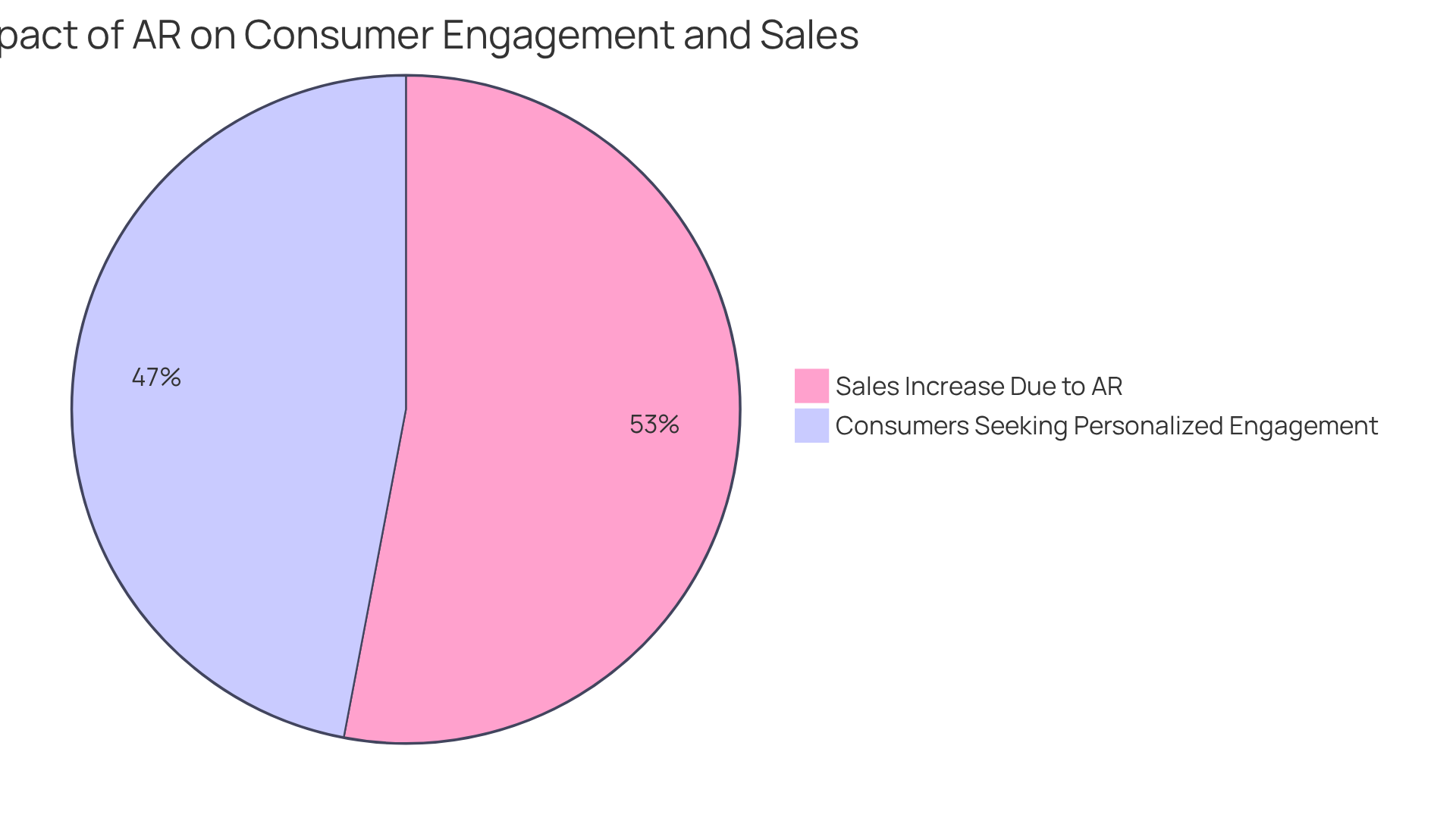
Understanding the Core Differences Between Augmented Reality and Virtual Reality
Augmented Reality (AR) enhances the real world by superimposing digital information onto physical settings, enabling individuals to engage with products in their genuine context. This technology, easily accessible through smartphones and tablets, presents a practical choice for consumers.
In contrast, when discussing VR vs AR, Virtual Reality (VR) immerses individuals in entirely virtual environments, typically requiring specialized headsets, which can limit its accessibility. Research indicates that consumer adoption rates for VR vs AR devices are expected to grow significantly by 2025, particularly among younger generations.
For product managers, understanding these distinctions is essential for effective audience engagement strategies. When comparing VR vs AR, it is evident that AR is especially useful for engaging product demonstrations, allowing clients to visualize items in their own environment, while VR provides completely immersive brand interactions that can transport users to enchanting virtual realms.
As Ken Braun notes, 'The discussion of VR vs AR is quickly becoming integral to marketing strategies across industries.' Brands that leverage these technologies will be well-positioned to create memorable interactions and foster deeper connections with their audiences.
However, challenges such as technical limitations and content creation costs must also be considered when adopting AR and VR strategies. Significant instances, such as Pepsi Max's AR campaign that transformed a dull bus stop wait into a memorable event and The North Face's VR initiative that enabled patrons to virtually hike famous sites, highlight the impact of storytelling through these immersive technologies.
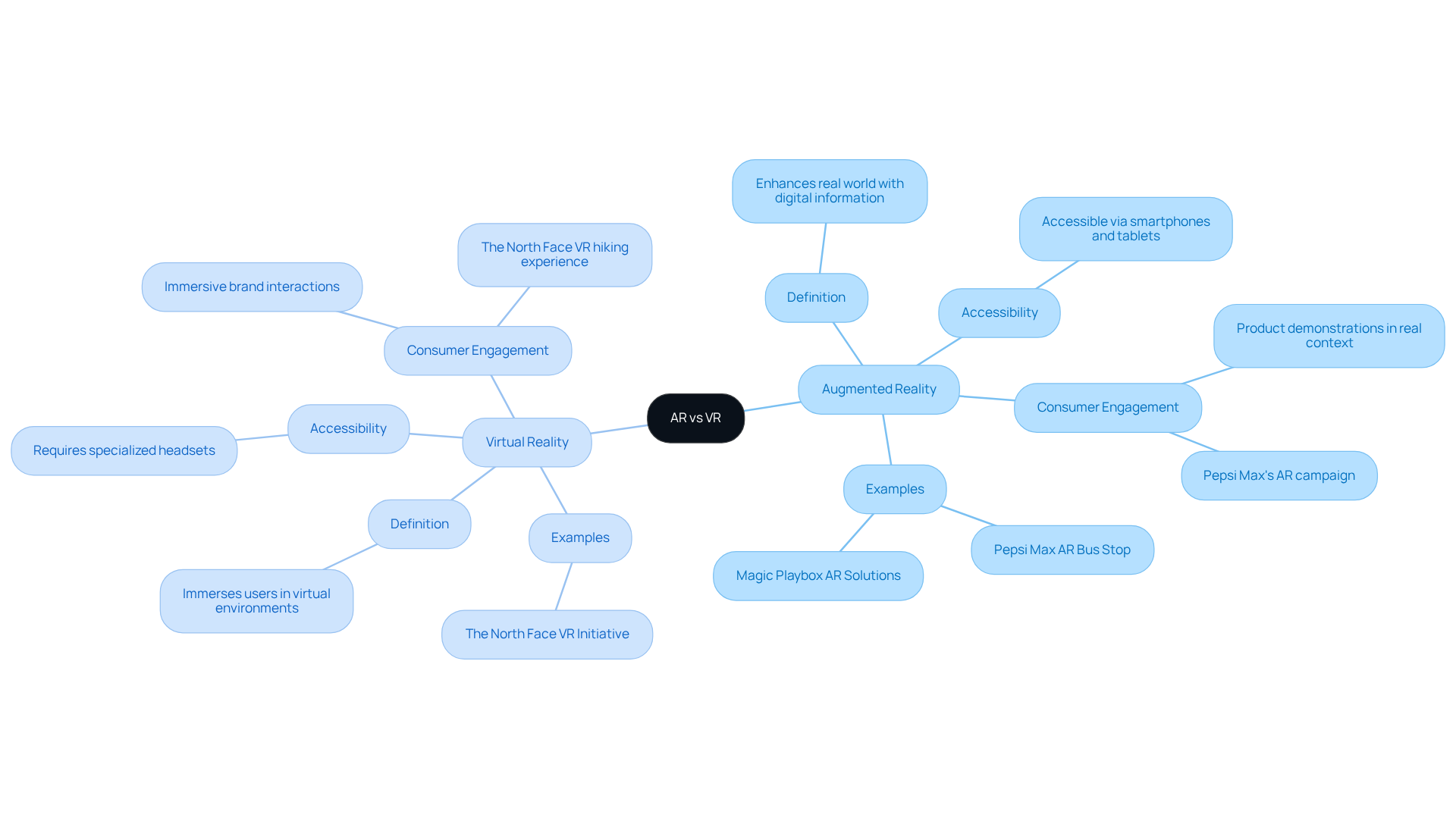
Utilizing AR and VR in Marketing Strategies: Key Applications for Brand Managers
Brand managers can significantly elevate their marketing strategies by harnessing the power of VR vs AR. AR technology facilitates virtual try-ons, enabling customers to visualize how products will look on them before making a purchase. This capability not only enhances the shopping experience but also fosters confidence, leading to a notable reduction in return rates—research indicates that virtual try-ons can decrease returns by up to 20%. For instance, Clinique reported a remarkable 150% increase in conversion rates among users of their AR skin analysis mirror, showcasing the potential of AR to drive sales.
Conversely, when discussing VR vs AR, it is evident that VR creates immersive environments, such as virtual showrooms, where customers can explore products in a lifelike setting. This method allows companies to engage consumers interactively, thereby improving their overall experience. Successful implementations, like IKEA's AR app, which enables users to visualize furniture in their homes, have proven effective in alleviating the guesswork associated with online shopping.
Moreover, the comparison of VR vs AR shows that both can be utilized for interactive storytelling, allowing companies to communicate their narratives in engaging ways that resonate with consumers. Remarkably, companies that have incorporated these technologies into their marketing strategies have reported substantial improvements in consumer engagement and conversion rates, with some campaigns achieving increases of up to 80% in sales. As the landscape of e-commerce continues to evolve, the adoption of AR and VR technologies will be crucial for brands aiming to capture the loyalty of tech-savvy consumers.
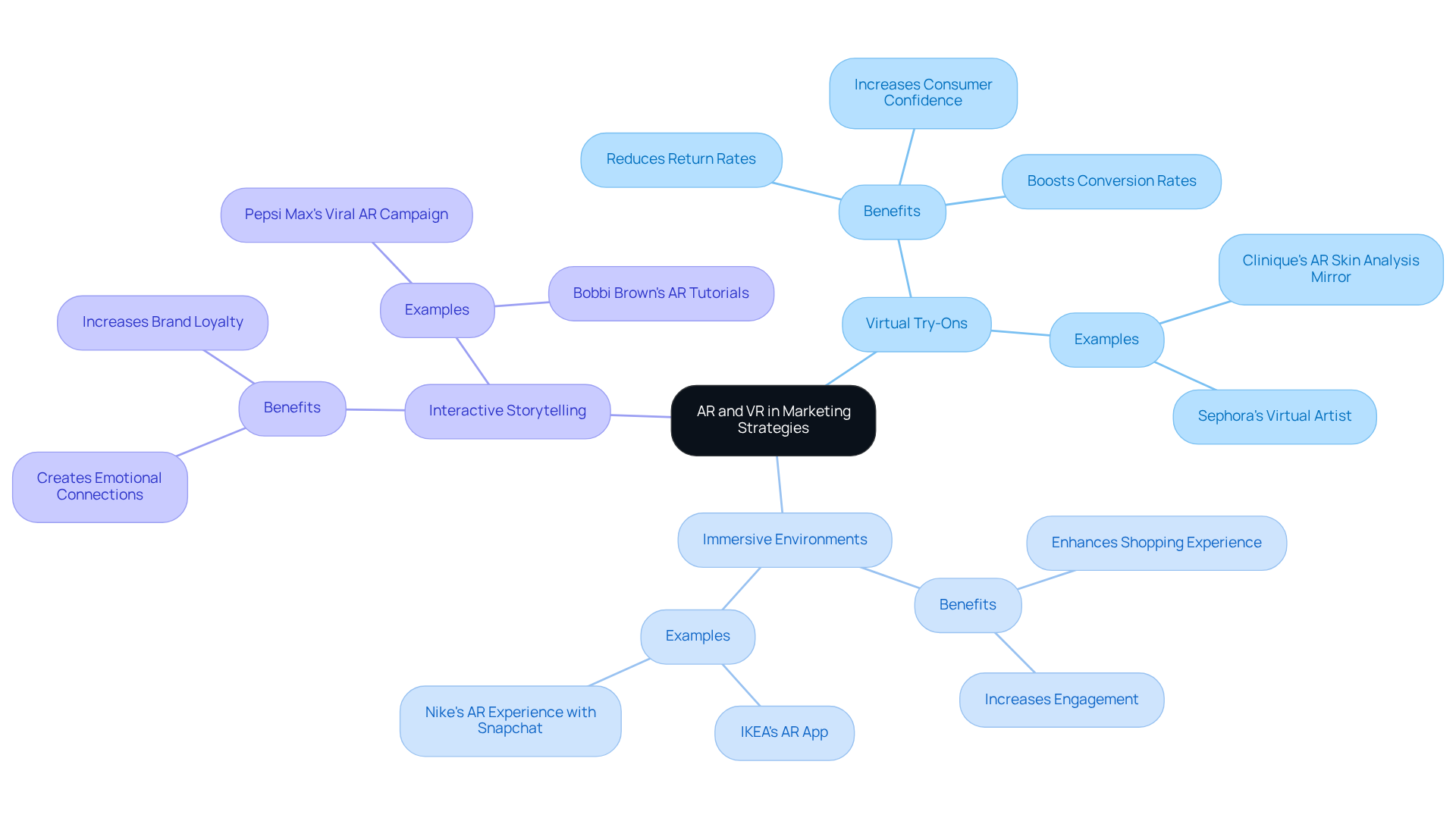
Comparing User Experiences: How AR and VR Engage Customers Differently
User experiences with Augmented Reality (AR) and Virtual Reality (VR) reveal distinct characteristics that significantly influence customer engagement, particularly when considering VR vs AR. AR enhances the real-world environment, enabling individuals to seamlessly engage with digital elements integrated into their surroundings. For instance, AR applications can provide contextual product information while individuals browse in-store, fostering immediate relevance and engagement. Research indicates that AR can boost sales by up to 80% by providing immersive product visualizations that enhance customer confidence and reduce return rates.
Conversely, VR offers a fully immersive experience, transporting users to entirely different environments. This capability is particularly effective for storytelling and forming emotional connections with businesses. Companies can utilize VR to create engaging narratives that resonate deeply with consumers, enhancing loyalty and recall. The emotional influence of virtual reality interactions can lead to increased conversion rates, as users feel a stronger connection to the company's narrative.
As we approach 2025, understanding the differences in VR vs AR is crucial for companies aiming to optimize their marketing strategies. In the debate of VR vs AR, while AR is ideal for immediate, interactive engagement, VR excels in delivering profound, memorable experiences. By leveraging both technologies appropriately, companies can create tailored marketing strategies that maximize customer interaction and drive sales.
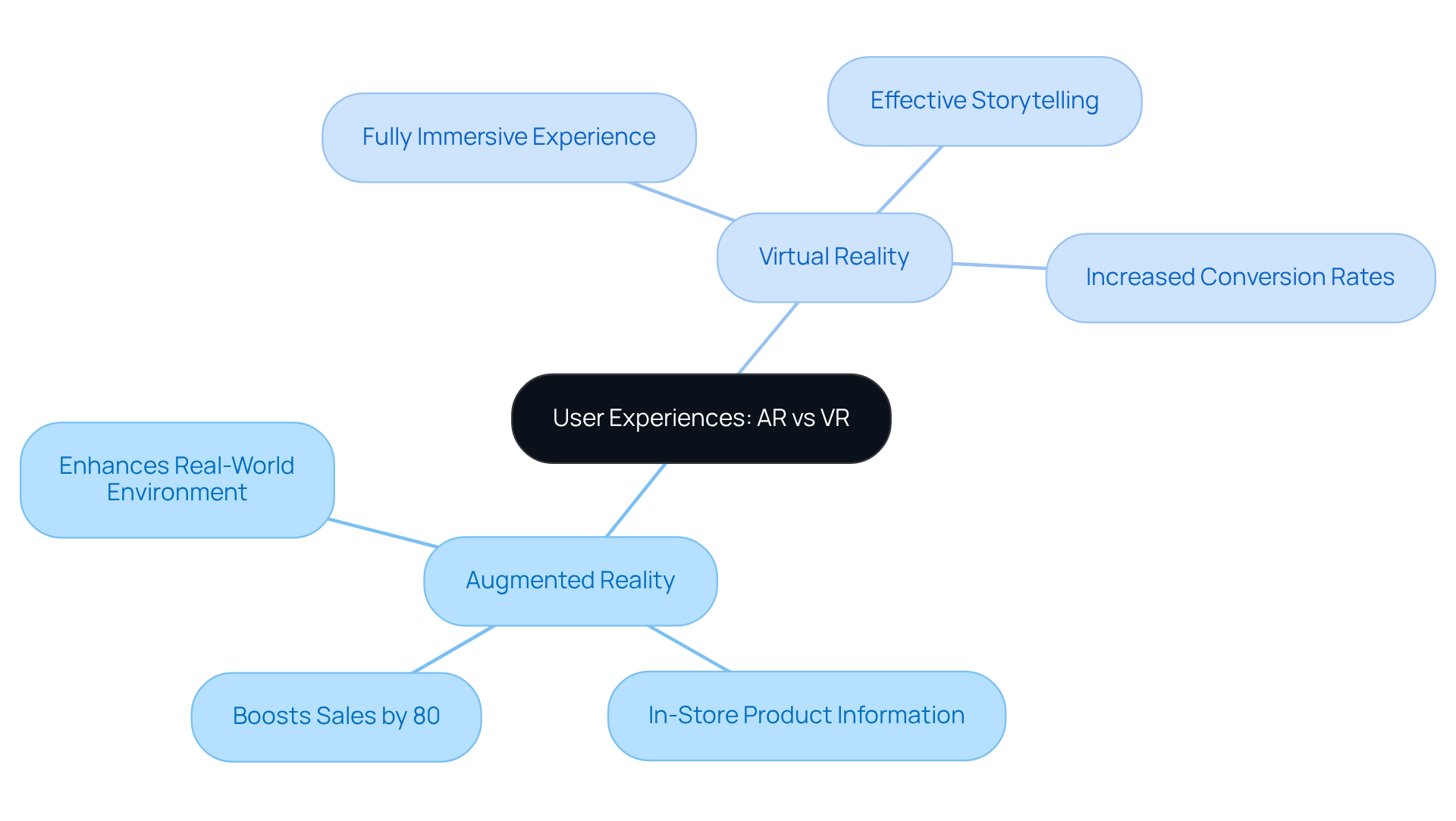
Technological Requirements for AR and VR: What Brand Managers Need to Know
Implementing technologies for VR vs AR requires specific hardware and software tailored to the unique demands of each platform. For augmented reality, brand managers must prioritize mobile devices that boast robust processing power and advanced camera capabilities. Utilizing development platforms such as ARKit or ARCore is essential for crafting effective augmented reality applications. Conversely, virtual reality necessitates high-performance headsets like the Oculus Rift or HTC Vive, paired with powerful computers that can run immersive applications. Understanding the available software development kits (SDKs) is crucial for facilitating seamless interactions.
Notably, companies such as Nike have effectively leveraged AR technology to enhance engagement, while IKEA's AR application allows individuals to visualize furniture within their homes, illustrating the vast potential of these immersive solutions. Magic Playbox stands at the forefront of this innovation, pioneering immersive AR and XR experiences that significantly boost company engagement and customer loyalty. Investing in the right technology, particularly solutions offered by Magic Playbox, is vital for maximizing the impact of AR and VR initiatives, especially when evaluating VR vs AR, as these tools can dramatically enhance user interaction and drive sales.
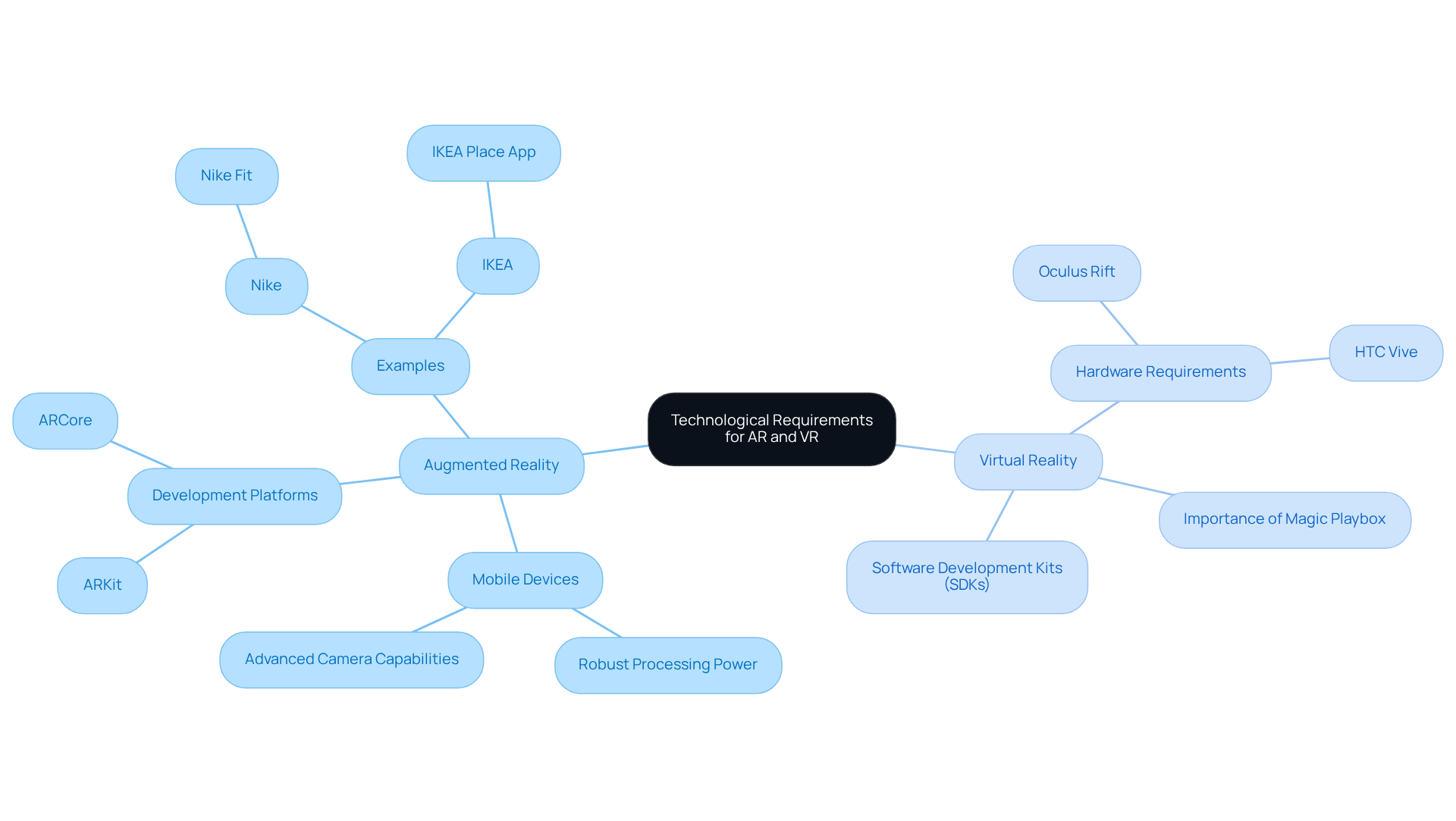
Cost Analysis: Budgeting for Augmented Reality vs. Virtual Reality Initiatives
When budgeting for initiatives, brand managers must consider various cost factors related to VR vs AR.
- AR projects can range from $5,000 to $150,000, depending on complexity and features.
- In contrast, the discussion of VR vs AR projects often reveals that VR projects typically start at $30,000 and can exceed $250,000 for high-end experiences.
Costs encompass software development, hardware procurement, and ongoing maintenance. It is crucial to assess the potential return on investment (ROI) by examining how these technologies can enhance client engagement and drive sales. A well-planned budget not only facilitates successful implementation but also yields measurable results. Engaging with experts in the field can further optimize your approach, ensuring that you navigate these investments wisely.
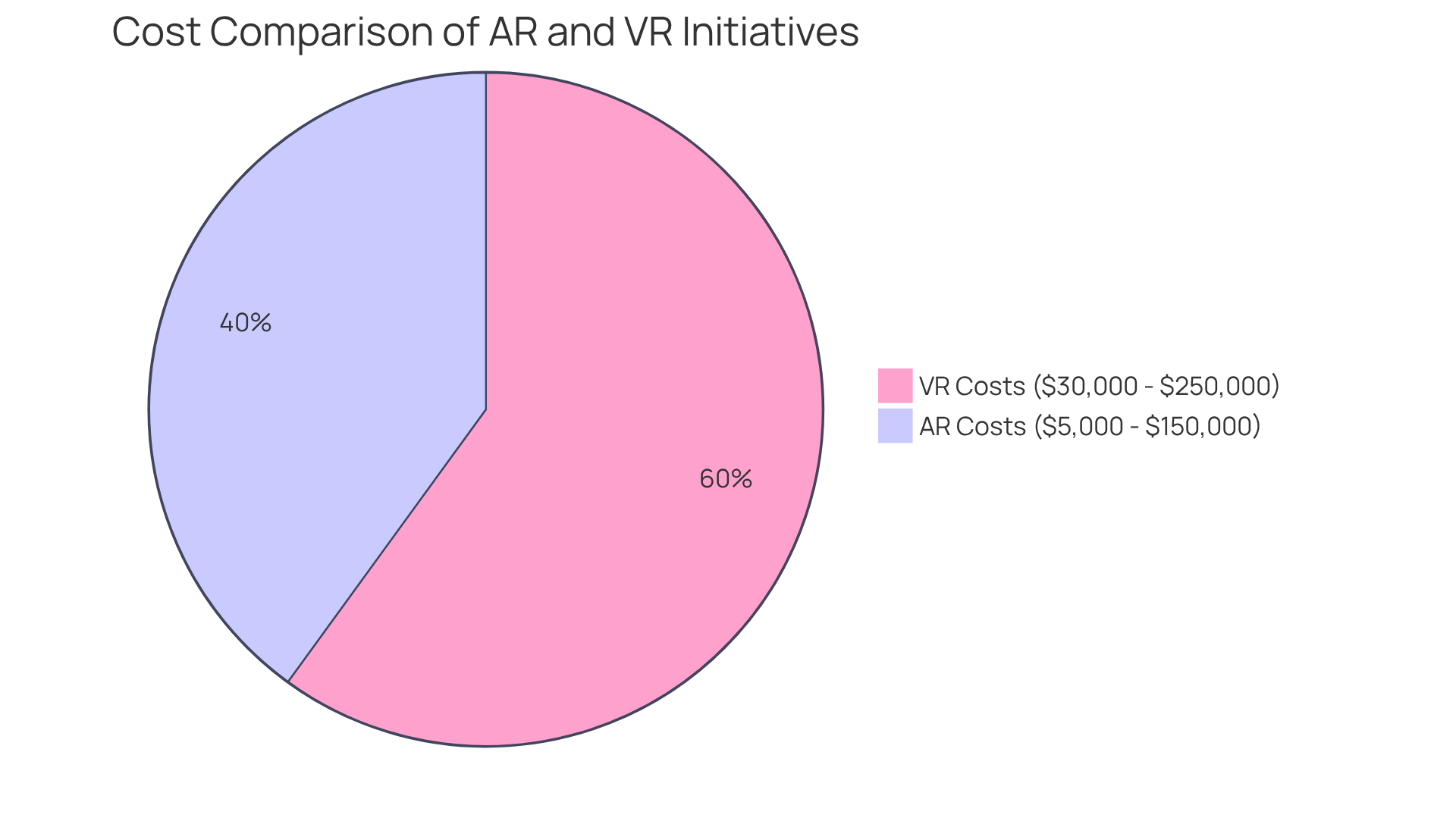
Measuring Customer Engagement: The Impact of AR and VR on Brand Interaction
To effectively measure customer engagement with initiatives involving VR vs AR, brand managers must prioritize key performance indicators (KPIs) such as:
- Interaction time
- Conversion rates
- Customer feedback
Interaction duration reveals how long individuals engage with content in VR vs AR, while conversion rates indicate the percentage of individuals who complete desired actions, such as making a purchase after an immersive experience. Customer feedback, collected through surveys, provides qualitative insights into user experiences and satisfaction levels.
Employing tools like Google Analytics allows companies to analyze behavior and engagement metrics, offering a quantitative perspective on how individuals interact with applications, particularly in the context of VR vs AR. Furthermore, advanced analytics tools can monitor interactions in real-time, enabling brands to adapt their strategies based on immediate feedback.
For instance, Sephora's Virtual Artist app has achieved notable success by allowing users to virtually try on makeup, resulting in heightened engagement and increased conversion rates. Similarly, IKEA's Place app enhances the shopping experience by enabling individuals to visualize furniture in their homes, which has been shown to reduce uncertainty and boost satisfaction.
By comprehensively understanding how customers interact with content in the context of VR vs AR, companies can refine their marketing strategies, leading to improved campaign effectiveness and stronger customer relationships. The integration of immersive technologies not only enhances customer engagement but also cultivates loyalty and repeat business, underscoring the necessity for e-commerce companies to prioritize these metrics in their performance evaluations.
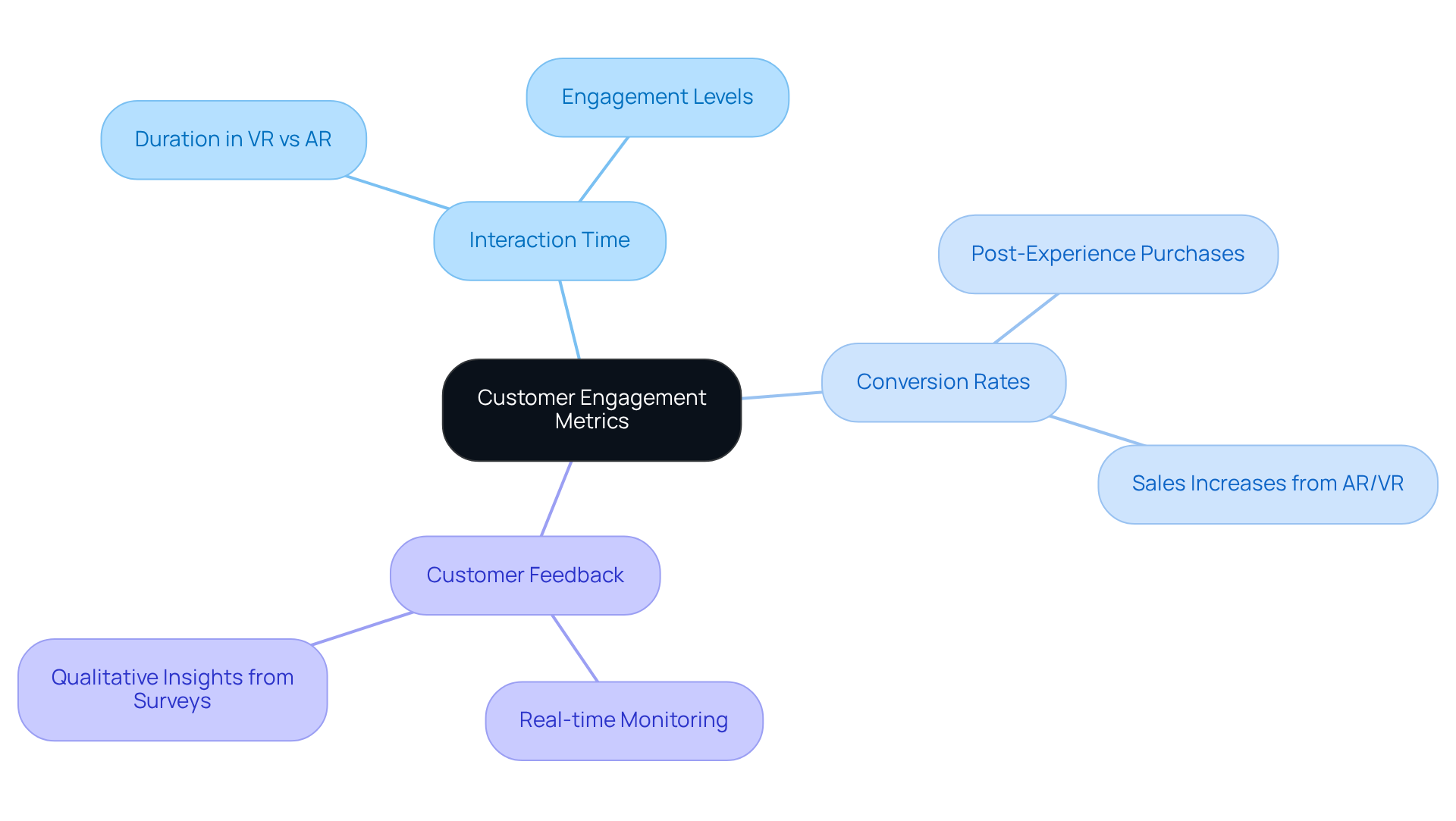
Future Trends in AR and VR: What Brand Managers Should Anticipate
As the technologies of AR and VR continue to evolve, it is imperative for managers to anticipate several key trends regarding VR vs AR. The integration of AI and machine learning is set to enhance personalization in interactions, emphasizing the distinctions between VR vs AR by allowing companies to tailor content to individual user preferences.
Research indicates that:
- 78% of consumers favor AI-enhanced AR interactions that facilitate real-time engagement, underscoring the growing demand for customized connections.
- The global augmented reality market is projected to exceed $50 billion by 2025, indicating substantial growth potential for companies considering investment in these technologies.
- The mobile AR market is expected to reach $36 billion by 2026, making these technologies more accessible and affordable, which is likely to drive broader consumer adoption.
- Companies should also prepare for an increase in social AR applications, where users can share their experiences on platforms like Instagram and TikTok, further boosting visibility.
- Notably, AR has been proven to enhance retail by increasing consumer confidence and reducing return rates by 25% to 40%.
Staying informed about these trends will empower brands to seize new opportunities for customer engagement and loyalty.
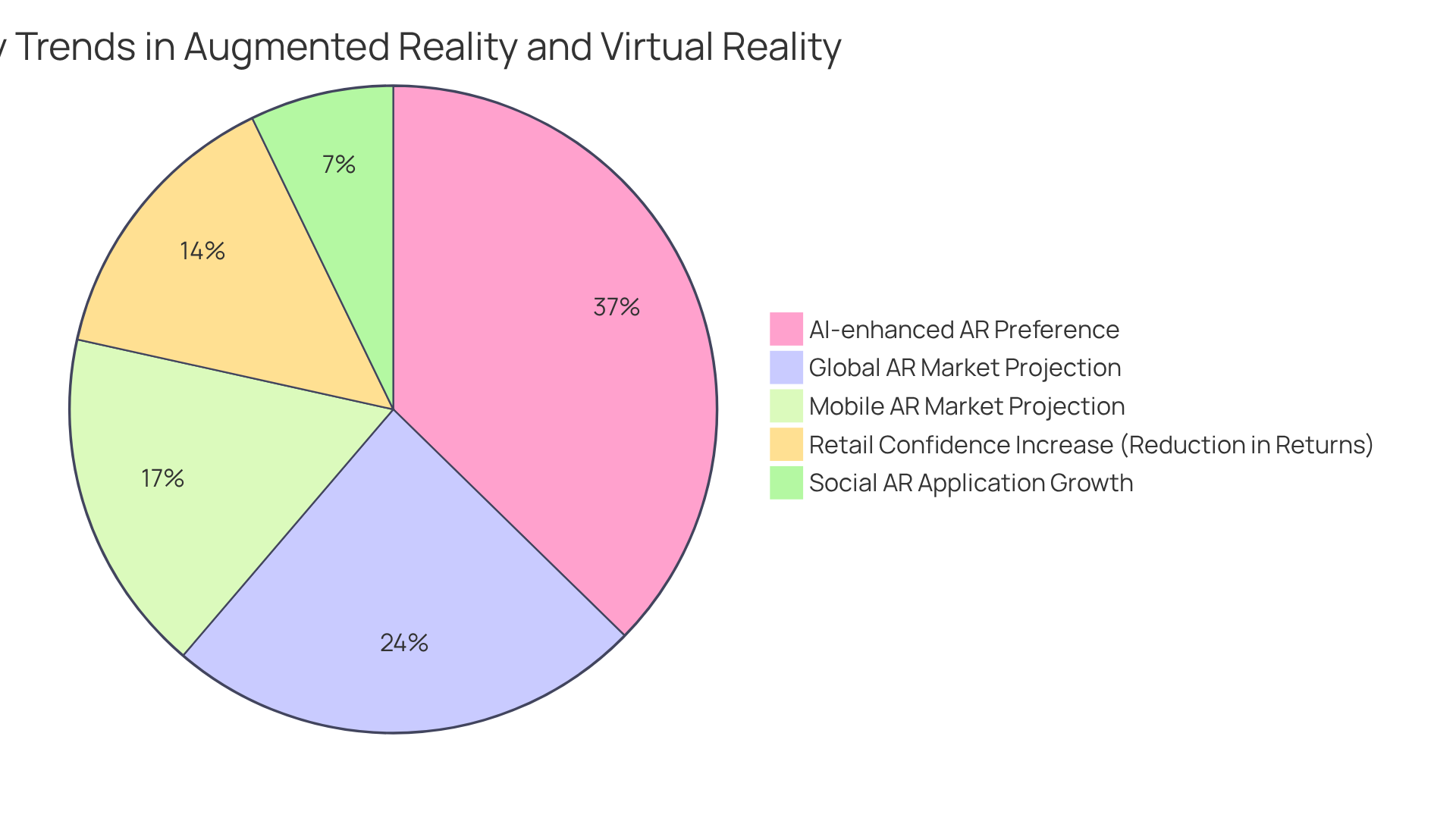
Challenges in Implementing AR and VR: Insights for Brand Managers
The challenges presented by implementing VR vs AR technologies can impede successful deployment. High development costs, technical limitations, and adoption barriers are significant hurdles. For instance, research indicates that 32% of AR/VR hardware users report that cumbersome devices and technical glitches deter them from engaging with these experiences. Furthermore, companies must tackle privacy issues and guarantee that their AR and VR products are intuitive and user-friendly to promote engagement.
To effectively overcome these challenges, brand managers should prioritize thorough market research to understand consumer preferences and behaviors. Collaborating with experienced developers can also streamline the implementation process, ensuring that technical aspects are handled efficiently. Additionally, concentrating on design for users is essential; immersive interactions should be enhanced for mobile gadgets, as older smartphones might not support high-resolution AR material, resulting in unsatisfactory client encounters.
Companies that have effectively overcome these obstacles frequently allocate resources for practical training for staff and supervised interactions for clients, which can greatly improve user adoption rates. For example, companies integrating AI with AR have reported increased engagement and sales, demonstrating the potential of personalized experiences. By proactively addressing these obstacles, companies can enhance their chances of successful implementation and maximize the benefits of technologies in the VR vs AR landscape. Significantly, the AR market is expected to expand from $1 billion in 2016 to $50 billion by 2024, highlighting the urgency for companies to embrace these technologies. Moreover, sectors such as healthcare and education, which possess a 41% investment rate in AR and VR, offer valuable insights for e-commerce companies aiming to innovate. By highlighting the possible sales increases of up to 80% through AR integration, companies can better grasp the business rationale for overcoming these challenges.
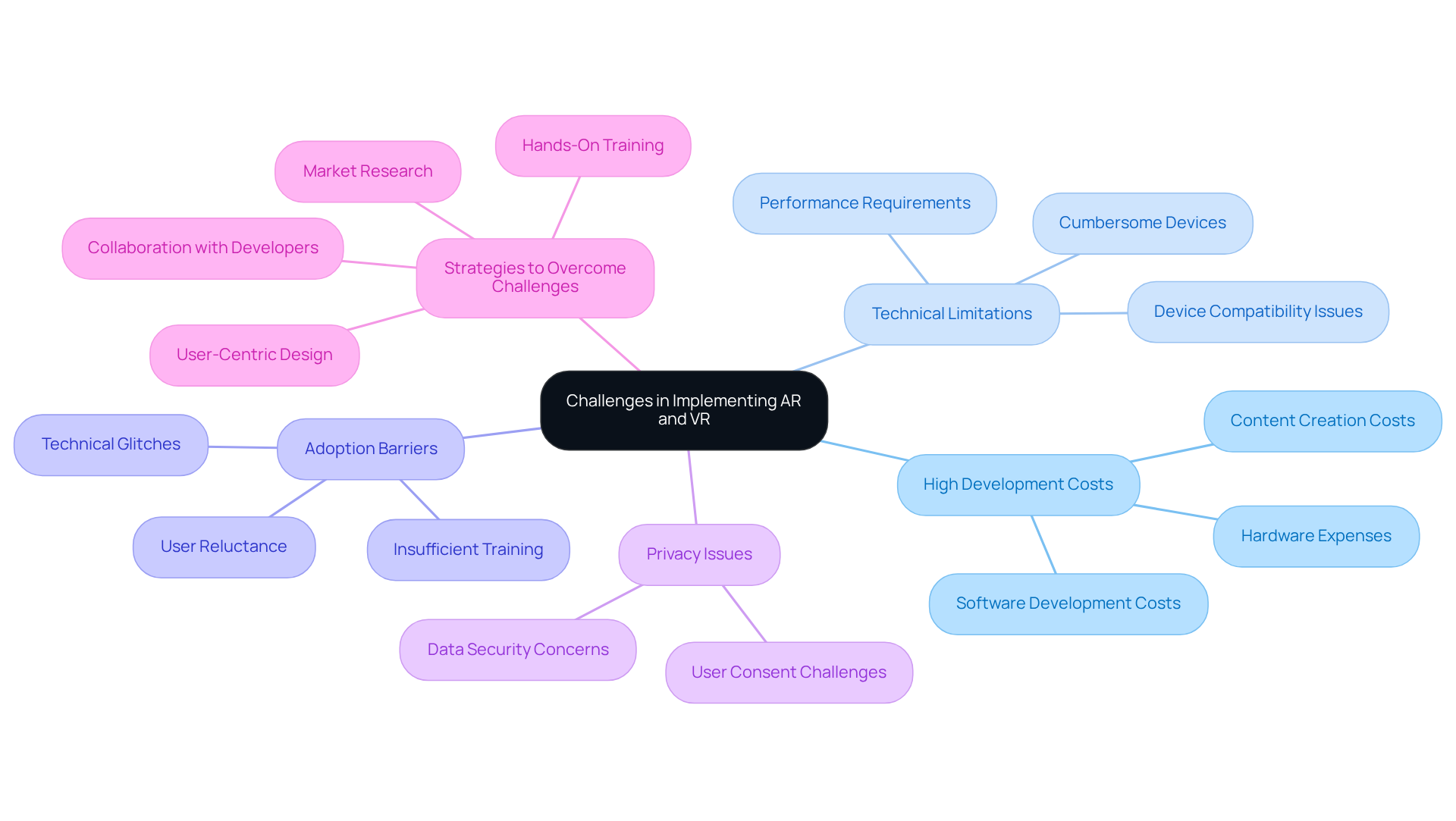
The Role of Storytelling in AR and VR: Engaging Customers Through Narrative
Storytelling is paramount in enhancing the effectiveness of experiences when comparing VR vs AR. By crafting compelling narratives, companies can forge immersive environments that resonate emotionally with individuals.
For instance, research indicates that AR enhances storytelling by integrating interactive elements, allowing users to explore a company's history and values. Similarly, VR immerses users in narrative-driven settings where they can engage with a company's message firsthand.
By embedding storytelling within their strategies for VR vs AR, brands not only foster deeper connections with their audience but also drive meaningful engagement.
Embrace the power of storytelling to elevate your XR initiatives and connect with your audience like never before.
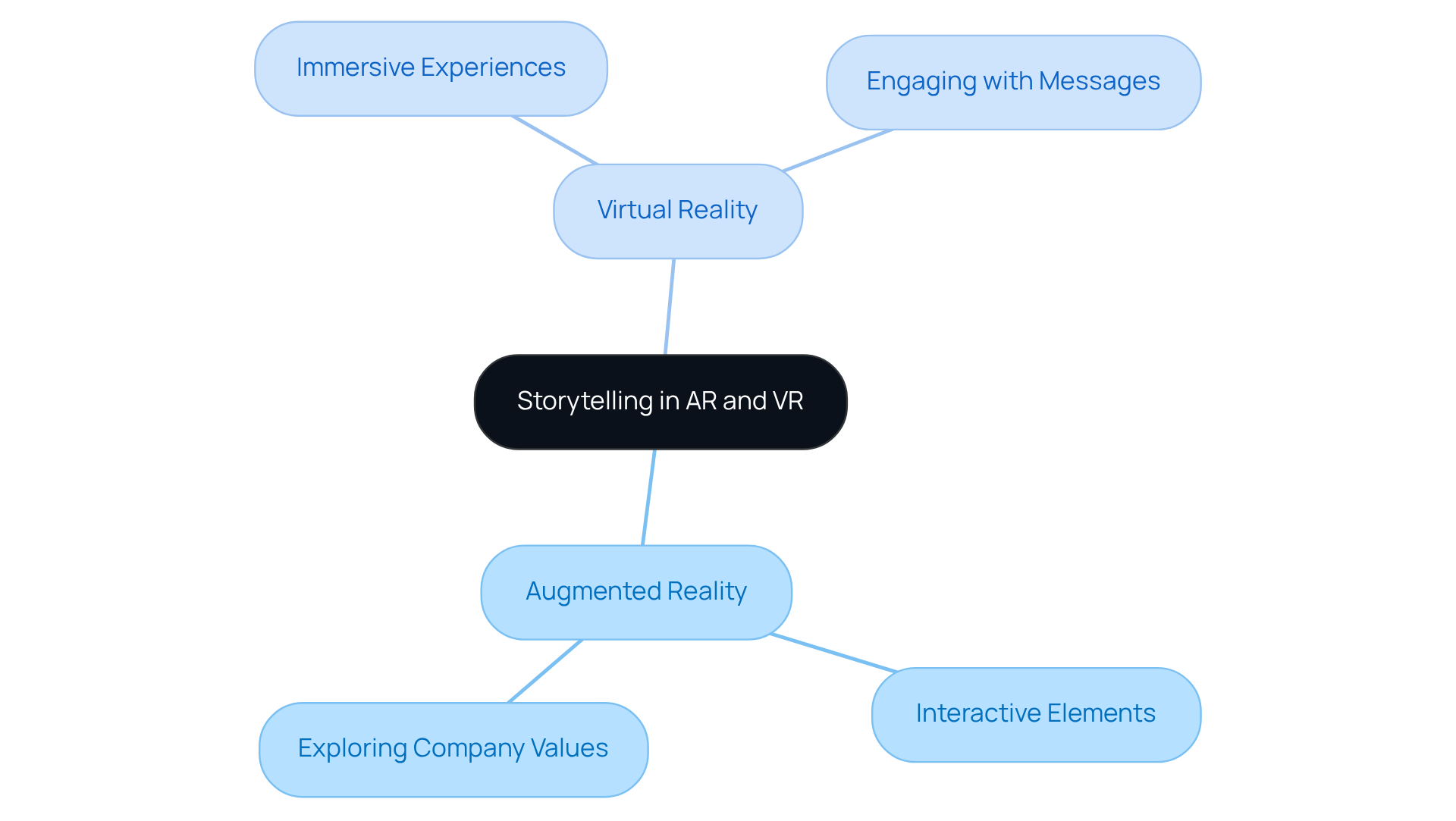
Conclusion
The exploration of augmented reality (AR) and virtual reality (VR) unveils their transformative potential for e-commerce brand managers. By comprehensively understanding the distinct characteristics and applications of these technologies, brands can craft more engaging and personalized customer experiences that drive loyalty and enhance sales. As AR and VR continue to evolve, their integration into marketing strategies becomes crucial for brands striving to remain competitive in a rapidly changing landscape.
Key insights reveal that:
- AR is particularly effective for enhancing product visualization and customer confidence.
- VR excels in creating immersive storytelling experiences.
Successful instances, such as Clinique's AR skin analysis mirror and IKEA's AR app, illustrate how these technologies can significantly boost conversion rates and diminish return rates. Moreover, the importance of technological readiness, cost analysis, and effective measurement of customer engagement cannot be overstated, as these factors are essential for maximizing the impact of AR and VR initiatives.
In conclusion, embracing AR and VR technologies presents a pathway for brands to innovate and deepen connections with tech-savvy consumers. As the market for these solutions continues to expand, brand managers are encouraged to invest in immersive experiences that resonate with their audience. By taking this decisive step, they can not only enhance customer engagement but also position their brands as leaders in the evolving e-commerce landscape.
Frequently Asked Questions
What is Magic Playbox and what does it offer?
Magic Playbox is a leader in the XR space, specializing in creating immersive Augmented Reality (AR) solutions that enhance brand engagement through interactive experiences.
How does Magic Playbox's AR technology benefit brands?
Their AR applications allow users to visualize products in their own environments, making the shopping experience more personal and engaging, which fosters customer loyalty and enhances product visibility.
What consumer demand does Magic Playbox's approach align with?
Magic Playbox's approach aligns with the growing consumer demand for personalized interactions, as 71% of individuals seek customized engagements from brands.
How effective is AR in increasing sales?
Research indicates that AR can increase sales by up to 80%, demonstrating its effectiveness in boosting customer engagement and conversion rates.
What are the core differences between Augmented Reality (AR) and Virtual Reality (VR)?
AR enhances the real world by superimposing digital information onto physical settings, while VR immerses individuals in entirely virtual environments, requiring specialized headsets.
Why is understanding the differences between AR and VR important for product managers?
Understanding these distinctions is crucial for developing effective audience engagement strategies, as AR is particularly useful for product demonstrations, whereas VR provides immersive brand interactions.
What challenges exist when adopting AR and VR technologies?
Challenges include technical limitations and the costs associated with content creation for both AR and VR strategies.
How can AR technology enhance the shopping experience?
AR facilitates virtual try-ons, allowing customers to visualize how products will look on them, which enhances confidence and can reduce return rates by up to 20%.
Can you provide an example of a successful AR implementation?
Clinique's AR skin analysis mirror resulted in a 150% increase in conversion rates among users, showcasing the potential of AR to drive sales.
How does VR contribute to marketing strategies?
VR creates immersive environments, such as virtual showrooms, allowing customers to explore products interactively, thereby enhancing their overall experience.
What impact do AR and VR technologies have on consumer engagement?
Companies that have incorporated these technologies into their marketing strategies report significant improvements in consumer engagement and conversion rates, with some campaigns achieving up to 80% increases in sales.




